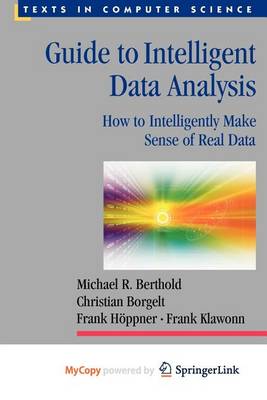Texts in Computer Science
3 total works
Computational Intelligence
by Rudolf Kruse, Christian Borgelt, Christian Braune, Frank Klawonn, Christian Moewes, and Matthias Steinbrecher
Guide to Intelligent Data Analysis
by Michael R Berthold, Christian Borgelt, and Frank H Ppner
Yet this is not the case. Although large databases allow us to retrieve many different single pieces of information and to compute simple aggregations, general patterns and regularities often go undetected. Furthermore, it is exactly these patterns, regularities and trends that are often most valuable.
To avoid the danger of "drowning in information, but starving for knowledge" the branch of research known as data analysis has emerged, and a considerable number of methods and software tools have been developed. However, it is not these tools alone but the intelligent application of human intuition in combination with computational power, of sound background knowledge with computer-aided modeling, and of critical reflection with convenient automatic model construction, that results in successful intelligent data analysis projects. Guide to Intelligent Data Analysis provides a hands-on instructional approach to many basic data analysis techniques, and explains how these are used to solve data analysis problems.
Topics and features: guides the reader through the process of data analysis, following the interdependent steps of project understanding, data understanding, data preparation, modeling, and deployment and monitoring; equips the reader with the necessary information in order to obtain hands-on experience of the topics under discussion; provides a review of the basics of classical statistics that support and justify many data analysis methods, and a glossary of statistical terms; includes numerous examples using R and KNIME, together with appendices introducing the open source software; integrates illustrations and case-study-style examples to support pedagogical exposition.
This practical and systematic textbook/reference for graduate and advanced undergraduate students is also essential reading for all professionals who face data analysis problems. Moreover, it is a book to be used following one's exploration of it.
Dr. Michael R. Berthold is Nycomed-Professor of Bioinformatics and Information Mining at the University of Konstanz, Germany. Dr. Christian Borgelt is Principal Researcher at the Intelligent Data Analysis and Graphical Models Research Unit of the European Centre for Soft Computing, Spain. Dr. Frank Hoeppner is Professor of Information Systems at Ostfalia University of Applied Sciences, Germany. Dr. Frank Klawonn is a Professor in the Department of Computer Science and Head of the Data Analysis and Pattern Recognition Laboratory at Ostfalia University of Applied Sciences, Germany. He is also Head of the Bioinformatics and Statistics group at the Helmholtz Centre for Infection Research, Braunschweig, Germany.
Guide to Intelligent Data Science
by Michael R Berthold, Christian Borgelt, Frank Hoeppner, Frank Klawonn, and Rosaria Silipo
Making use of data is not anymore a niche project but central to almost every project. With access to massive compute resources and vast amounts of data, it seems at least in principle possible to solve any problem. However, successful data science projects result from the intelligent application of: human intuition in combination with computational power; sound background knowledge with computer-aided modelling; and critical reflection of the obtained insights and results.
Substantially updating the previous edition, then entitled Guide to Intelligent Data Analysis, this core textbook continues to provide a hands-on instructional approach to many data science techniques, and explains how these are used to solve real world problems. The work balances the practical aspects of applying and using data science techniques with the theoretical and algorithmic underpinnings from mathematics and statistics. Major updates on techniques and subject coverage (including deep learning) are included.
Topics and features: guides the reader through the process of data science, following the interdependent steps of project understanding, data understanding, data blending and transformation, modeling, as well as deployment and monitoring; includes numerous examples using the open source KNIME Analytics Platform, together with an introductory appendix; provides a review of the basics of classical statistics that support and justify many data analysis methods, and a glossary of statistical terms; integrates illustrations and case-study-style examples to support pedagogical exposition; supplies further tools and information at an associated website.
This practical and systematic textbook/reference is a “need-to-have” tool for graduate and advanced undergraduate students and essential reading for all professionals who face data science problems. Moreover, it is a “need to use, need to keep” resource following one's exploration of the subject.

